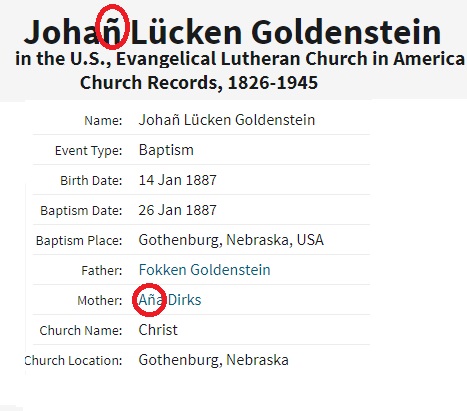
Her name was Anna and his name was Johann.
Ancestry.com in their digitized records from ELCA (Evangelical Lutheran Church in America–titled “U.S., Evangelical Lutheran Church of America, Records, 1826-1945”) transcribed the of the child in this 1887 baptismal entry as Johañ Lücken Goldenstein and the mother as Aña Dirks. Those marks in their first names are not tildes. They are lines indicating that the letter under the line is actually a double letter–Johann and Anna. It was a common practice in the time period.
The pastor had not created his own abbreviation that was not used elsewhere.
I always transcribe documents myself so the tildes are not in my transcriptions. Anyone importing the transcription directly into their database without making modifications will have these names. And if it is the preferred name they use for the ancestor, then Johann has become Johañ and Anna has become Aña. Another name variant for these individuals that is not really a name variant at all.
The fact that the names in the records of this church are Germanic in origin makes the use of the tilde all the more interesting. It’s not a diacritic used in Germanic languages.
I only rely on Ancestry.com‘s transcriptions when performing initial searches of databases–simply because it saves time.
For the most part the transcriptions of these records is fairly accurate. But those straight lines above the letters are straight lines not tildes.


No responses yet